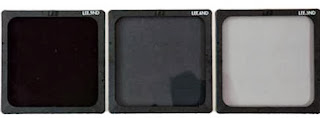Filters are transparent, or translucent, materials placed in front of camera, or light sources, to affect different qualities of light.
Light have different physical properties and manifestations. Light rays can fall on a surface to be absorbed, reflected or transmitted.
Light absorption by an opaque or translucent surface changes the incident light's color and brightness.
As white light is a mix of all pure light waves (pure wave = having a uniform wavelength between 380 nm – 700 nm), different substances absorb selective wavelengths.
It totally depends on the atomic structure of any material how it would look. A white substance reflects all wavelengths falling on it in the same proportion.
A gray substance reflects those wavelengths only, but absorbing equal percentage from all wavelengths.
So, in effect, gray is white less bright.
A black substance absorbs all wavelengths. So, black is white least bright.
As white, gray and black surfaces reflect all wavelengths of white light in same proportions, they are not considered as colors.
However, when a surface absorbs most wavelengths, but not all, the phenomenon of color occurs.
For example, when white light falls on a red ball (or, any other red object) the surface of the object absorbs all the wavelengths except red, due to molecular or atomic properties of the surface. As red waves are reflected off the ball, it looks red.
So, in a way, all objects – opaque or translucent – filter some wavelengths while releasing others. However, only the translucent materials that transmit only part of wavelengths falling on them, thus changing the final image inside camera, are called Filters.
Filters are of two basic types –
(a) for use on camera
(a) for use on camera
(b) for use on light
Depending on how they affect the final image, filters come in several categories.
Filters that affect the Intensity of light
(a) Neutral Density Filters (ND) : They come in different densities (darkness.) They are neutral in color, absorbing all wavelengths in the incident light equally. ND filters come as multiples of .3. There are ND 3,6,9 and 12 to be found in most shoots. Each .3 mark means that ND filter cuts one stop of light.
We use these filters on the camera so that we can cut the exposure while keeping the aperture open. These filters come handy where the scene requires a shallow Depth-of-Field.
They can be used for slow shutter speed photography, either for motion picture or still photography. An ethereal image is produced in such cases. Slow shutter speed appears as motion blur in the image, while an ND filter keeps the exposure normal.
A graduated filter is dense on one edge (top or bottom) and gradually clear as it goes to the opposite edge. Graduated ND filter is used to cut the overexposure from the sky, while keeping the ground exposure unchanged.
However, it is risky to use a graduated filter in motion picture photography. It can be used only in static frame shots where characters do not move much in the Z-axis.
All filters absorb some light. Some pass only selective frequencies, some bend lights in peculiar ways, some scatter them. But, all reduce the power of light – cutting the exposure.
ND filters cut only the exposure, keeping every other property of light intact.
(b) Polarizer : Polarizers are used both on camera lens and on lights. While a polarizing screen fitted to a light source polarizes the normal light.
When a polarizer filter is mounted on camera lens, it works on already polarized light, by completely or partially blocking it.
Just like any other filter, polarizers absorb some amount of light too. But, while it allows unpolarized light after reducing its power, it can completely block polarized light from passing.
Sources from where polarized light is coming turns totally black with a polarizer on the lens, while rest of the image frame remains unaffected.
Filter Factor of a polarizer filter is roughly 2.5 stops.
(To be continued)









No comments:
Post a Comment